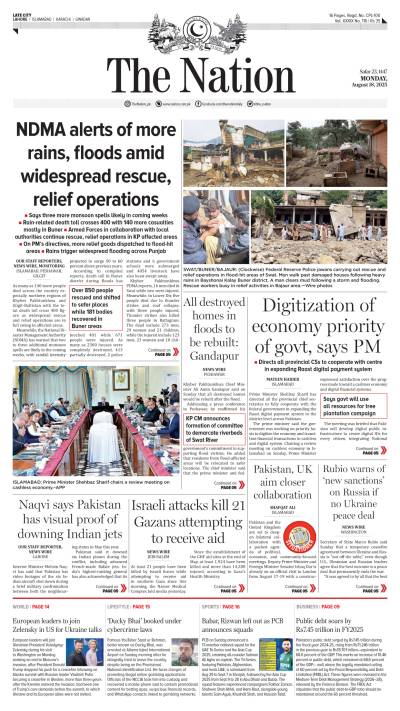The basic flaw in Indian policy formulation and decision-making has been its misinterpretation of strategic autonomy. India considers itself the natural hegemon and net security provider of the region — which thinks otherwise. There is a massive gap between its strategic ambitions (intent) and its capabilities. This inherent dichotomy in thought and action/capability has led to serious errors of judgement. Earlier, it attacked Pakistan on trumped-up charges and was dealt a telling and humiliating defeat by the redoubtable Pakistani Armed Forces. President Trump intervened and instituted a ceasefire. India erred by withholding the credit due to him. President Trump felt seriously miffed as it sullied his growing reputation as a world-class peacemaker.
Furthermore, India felt that it could run with the hare and hunt with the hound (strategic autonomy?) with abandon. It was a faux pas of the worst order. India thus ended up being a strategic ally of the US, a member of the QUAD and I2U2 alliances, as well as of the Sino-Russia-led SCO and BRICS. However, this Indian position was absolutely untenable. It simply did not have the class, credentials, clout, or heft to have a foot in both rival camps and be accepted as such. Its pantomime came crashing down as the US eventually pulled the rug from under its feet, derided it for importing Russian oil worth billions of dollars and thus, by implication, funding Russian aggression in Ukraine. It then imposed a hefty 50% tariff on its exports to the US. A further 10% tariff might yet be imposed for being part of BRICS, which ostensibly follows anti-US policies. India further failed to recognise that the US’ core national interest is to see itself as the unchallenged hegemon and most eminent economic and military power in the world. To that end, it will always move to counter China, its main challenger. Did India really expect the US to shift all supply chains from China and anchor them in its territory? Did it really think that the US would help develop it into a manufacturing hub that not only rivals China but also eventually replaces it? The US will never create a situation where the challenges it faces from China today might be replicated by a surging India at some later stage. India is just tasked to contain China. Period.
India has two options. One, it can swallow its pride, forego its infamous strategic autonomy, and meekly submit to US diktat and coercion. It could agree to becoming a subservient ally of the US and ride out the current storm. Two, it could show strategic defiance, stick to exercising its strategic autonomy, and chart out an independent course for itself. If it opts for Option One, it will further lose face, status, stature, and clout in the international arena. Domestic political opposition and unrest will be unbearable. Furthermore, it might have to fight the Chinese not for pursuing its own but essentially Uncle Sam’s vital interests. If it chooses Option Two, then it will face not only the ire of the US but also of all its European allies. That will generate dire consequences for it in the geopolitical, geostrategic, and geo-economic dimensions. The Indians might show the intent to defy the US, but do they really have the capacity to do so? India now finds itself stuck in a strategic cul-de-sac with nary a viable option in sight.
Pakistan needs to carry out a critical, albeit cold, analysis of the evolving geopolitical, geostrategic, and geo-economic environments. It must draw the right deductions and conclusions from the dizzying dynamics unleashed by the bewildering pace of the apparently contradictory US policies towards the region. President Trump is apparently rewriting the paradigms that will govern relations between the US and India as well as Pakistan. However, both must remember that regardless of the mechanics involved, the desired end-state of US policy will always be to establish itself as the sole, unchallenged hegemon of the world. To that end, it will confront and neutralise all challenges. Critically, as a part of its grand strategic design, it will always need India to counterbalance China — its oft-employed Strategy of Offshore Balancing refers. It can ill afford to lose it to the Sino-Russia Combine and is least likely to allow it. The current break in US-India ties is temporary and will be overcome the moment the issues of tariffs and oil imports from Russia are sorted out. The US and India both have an interest in containing the meteoric rise of China and are very likely to restore and reaffirm their strategic partnership sooner rather than later. It will be back to business as usual. Pakistan must be cognisant of this very critical point. On its part, it must have a very clear strategic vision, foresight, and strategy for the future. It must keep its vital national interests foremost. It must not get carried away by the bonhomie currently being shown. It has happened before too. Allowing foreign presence in Gilgit-Baltistan and Balochistan, the start and end points of the CPEC, will have serious, even drastic, strategic implications. The CPEC is its economic lifeline of the future. It must be guarded ruthlessly. Pakistan must not endanger a well-established strategic partnership for a traditionally fleeting, transactional one. Pakistan must look all gift horses in the mouth, very closely.
All said and done, does President Trump intend to reinvent and recalibrate the US approach to regional-global affairs, or will he eventually revert to the original paradigms of US foreign policy once the dividends of the current policy have been collected — and the Nobel Peace Prize won?
Imran Malik
The writer is a retired brigadier of the Pakistan Army. He can be reached at im.k846@gmail.com and tweets @K846Im.







